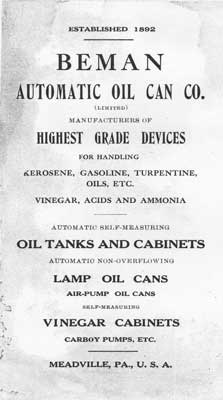 |
||||||
Early Gasoline Measuring
As soon as dispensing gasoline (and kerosene, during and before that) to the public was carried out on a large geographic scale, and particularly in cities, a visible and easily understood method and device for accurately demonstrating the amount served became necessary. The marketer was required to account for the exact amount sold and underfills, overfills and spills leading to customer squabbles had to be avoided. Pouring directly from the filling tank into a one gallon or five gallon can at a busy street corner was subject to distractions and spills at times (even when using a funnel).
In 1890 gasoline sold in Chicago for 4-1/2 cents per gallon and in 1899 the price was up to 7 cents per gallon. One use in the late 1800’s was for lighting (stores, factories and street lamps), but kerosene was the principal illuminant in homes. By 1897 the use of gasoline for stoves, heaters and stationary engines was noticeable, dangerous as it was. Later, in the early 1900’s, gasoline-powered vehicles caused an enormous demand as compared to gasoline sales in the 1890’s, and that’s when measuring and efficient dispensing began to become very important.
In 1891 automatic measures were installed on the horse-drawn tank wagons of the Atlantic Refining Company (Hidy & Hidy, 1955) whose marketing territory would increase to cover all of Pennsylvania and Delaware by 1911. Tank wagons of other companies and sales territories followed suit. The 1891 products were mostly kerosene although some gasoline was sold in the pre-automobile era as mentioned above. Dispensing gasoline for the new automobiles (and gasoline engines in general) gained importance after the turn of the century and especially by 1910 when trucks were becoming common on the roads. The Great War created a huge demand by 1916, and afterwards the modern gasoline stations proliferated.
 |
Cover of Beman’s little red catalog booklet of 1911. |
| © 2004, Samuel T. Pees all rights reserved |
|